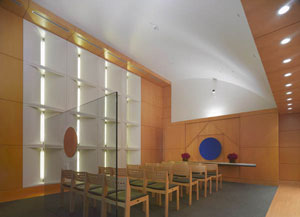The shift to meditation rooms mirrors a growing trend among hospitals nationwide as health care centers try to make room for people from a wide variety of faiths, as well as those who have no faith or are “spiritual but not religious.”
In a stressful environment, hospital chapels, meditation rooms or prayer rooms offer employees, patients and visitors quiet refuge for individual prayer, meditation or communal worship.
Throughout the 19th century, many U.S. hospitals were built by religious groups, particularly Catholic nuns. As a result, their chapels typically resembled Protestant or Catholic churches or Jewish synagogues.
Today, hospital chapels vary widely. Some still reflect their founders’ religious roots. Others have been renovated to accommodate multiple religions, or their religious symbols have been removed so the rooms resemble waiting rooms or art galleries.
“There was a diversity for a long time that was Christian diversity,” said the Rev. George Handzo, vice president of pastoral care leadership and practice at HealthCare Chaplaincy, based in New York City.
Staff and patient populations at many U.S. hospitals are much more diverse than they once were, and hospitals know it makes good business sense to accommodate them, Handzo said. “They don’t want to lose those people to the place down the street.”
Some hospitals have Jewish family rooms or Shabbos rooms, which can be stocked with couches, prayer books, kosher food and kitchen appliances. Located in hospitals or nearby apartments, they are typically paid for by the local Jewish community.
Some prayer rooms are outfitted for Muslim worship. Five years ago, Boston’s renowned Massachusetts General Hospital installed a mihrab, or ornately tiled archway, in a prayer room to help Muslims orient themselves toward Mecca during prayer.
Washington, D.C.’s Georgetown University Hospital added Muslim prayer rugs at the back wall of its Catholic chapel, and later removed the Stations of the Cross facing Mecca, said the Rev. Brian Conley, the Jesuit hospital’s director of mission and pastoral care.
Check out the rest at the Beliefnet link.


